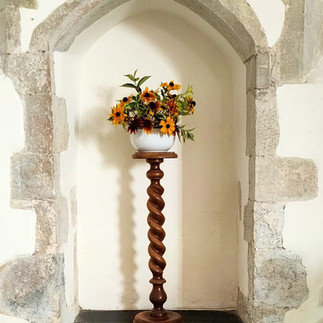We Plough The Fields and Scatter
- ZMS
- Oct 11
- 3 min read

The children of Stelling Minnis school celebrated their Harvest Festival at St Marys on Wednesday 8th October.
The children had walked the short distance from the school – across the Minnis and the fields, leaving their wellies in the outer porch.Their joyful voices filled the church with their songs and stories celebrating the harvest. Parents watched from the gallery – perhaps remembering when they too made their donations of food items and sang their favourite Harvest hymns.

An ancient church, St Marys will have borne witness to many Harvest celebrations over the centuries, and while the way in which we celebrate this festival has changed, the joyfulness of the occasion remains the same.This year’s donations of food items will be going to Thanington Resource Centre Food Bank.
Feast, Fair, and Festival: Bringing Home the Harvest in 15th Century England
The period of "bringing home the harvest" in 15th-century England was not a single day of celebration, but a climactic season that blended arduous labour with community-wide festivities and deep religious significance. Life in medieval England revolved entirely around the agricultural year, making the safe gathering of crops a moment of profound relief and joyous release.
The Lay Celebrations: Harvest Home and Mell Feasts
The most immediate and boisterous celebrations were secular, marking the end of the intensive work on a single farm. This was known as the Harvest Home or the Mell Feast (or Harvest Supper).
The Feast: These celebrations were traditionally hosted by the farmer for all the workers who had helped gather the crops. They were renowned for their generosity, providing a substantial meal—a rare treat for the poorest labourers—with plenty of meat, spiced dishes, and strong ale or cider.

Rural Customs: The end of the harvest season was marked by various folk rituals in the fields, such as crafting a "corn dolly" from the very last sheaf of grain. This was believed to house the spirit of the corn and was carefully stored until the next spring's planting to ensure a good future crop.
Hiring Fairs and Revels: Following the individual farm celebrations, a larger period of change and festivity occurred in late September and early October, culminating in the
Michaelmas fairs. These were not just social gatherings; they were vital economic events where farmworkers were hired or dismissed for the coming year, rents were paid, and business was mixed with games, revelry, and market stalls.
The Church's Role: Festivals and First Fruits
While the Harvest Home was a celebration of manorial and village life, the Christian Church integrated the harvest into its liturgical calendar, offering moments for spiritual thanks and obligation.
Lammas (August 1st): This ancient Christian feast, known as "Loaf Mass Day" (Hlāfmæsse in Old English), marked the beginning of the harvest season, particularly for the cereal crops. It was celebrated by bringing a loaf of bread, baked from the very first of the new wheat crop, to the local church to be blessed during the Mass. This act sanctified the initial bounty and gave thanks for the promise of the full harvest to come.
Michaelmas (September 29th): The Feast of St. Michael and All Angels was one of the four key "quarter days" in the medieval year, aligning with the traditional end of the full harvest season. In the church, it was celebrated with a special Mass, prayers, and processions dedicated to St. Michael.
Feudal and Religious Ties: While a religious holiday, its timing made it crucial to the agricultural economy. Tenants paid their rents and dues (often in kind, or with a traditional Michaelmas goose), and the day symbolised both the end of summer's abundance and a call for divine protection against the harder winter months.
The Tithe: The church's most constant and direct link to the harvest was through the tithe, a mandatory payment of one-tenth of all agricultural produce (grain, livestock, milk, honey, etc.) to the local priest and church. The harvest season was therefore the period when these vast stores of produce—essential for the clergy's income and for the church's charitable works—were physically collected and housed in the great tithe barns.
Thus, in 15th-century England, the "bringing home the harvest" was a powerful moment that simultaneously honoured the toil of the labourers with a joyous communal feast, managed the economic cycle at the Michaelmas fairs, and gave spiritual thanks to God through the solemn Christian feasts of Lammas and Michaelmas.










Comments